The relationship between alcohol consumption and related harm among young university students
Ellen Hart A and Sharyn Burns A BA Collaboration for Evidence, Research, and Impact in Public Health, Curtin University, GPO Box U1987, Perth, WA 6845, Australia.
B Corresponding author. Email: S.Burns@curtin.edu.au
Health Promotion Journal of Australia 27(1) 15-20 https://doi.org/10.1071/HE15086
Submitted: 20 July 2015 Accepted: 4 November 2015 Published: 1 February 2016
Journal Compilation © Australian Health Promotion Association 2016
Abstract
Issue addressed: Research has shown that Australian university students consume alcohol at a higher level than their peers from the general population and are therefore more likely to witness and experience alcohol-related harm. This study measured the prevalence of alcohol consumption among 18–24-year-old university students and the association between alcohol consumption and witnessed and experienced harms.
Methods: A random cross-sectional sample of university students aged 18–24 years (n = 2466) was recruited via the University Survey Office and through random intercept at campus market day. All participants completed an online survey that included the Alcohol Use Disorders Identification Test, Alcohol Problems Scale and an additional scale measuring witnessed harm.
Results: Principal Components Analysis revealed three factors within the Alcohol Problems Scale; i.e. Criminal and Aggressive Behaviour, Health and Emotional Harms and Sexual Harms. Students who consume alcohol at high-risk levels were significantly more likely to score highly on each factor, 1.6 times more likely to experience harm and 1.1 times more likely to witness harm than students who consume alcohol at low-risk levels.
Conclusions: The positive association between alcohol consumption and alcohol-related harm supports previous findings. This study adds previous research through the categorisation of harm into factors.
So what?: Integrated and comprehensive interventions addressing alcohol consumption among young university students that are informed by evidence-based research can be tailored to ensure that they meet the needs of the target group.
Introduction
Excessive alcohol consumption contributes to a range of health issues and related injuries.1 Despite knowledge of the risks of heavy alcohol consumption, it remains a cultural norm for young Australian adults to drink heavily during single sessions.2–4 The National Health and Medical Research Council recommend that to reduce the risk of alcohol-related injury during and immediately after drinking, healthy men and women consume no more than four standard drinks on any single occasion.1 Often the amount of alcohol consumed by young adults in Australia on a single occasion exceeds these guidelines1 with studies finding approximately half of Australian university students who drink consume more than five alcoholic drinks on most occasions when they are drinking, which is often several times a week.5–7 Almost 40% of people aged 20–29 consume alcohol at a level that puts them at a moderate to high risk of short-term harm.2 In particular males are more likely than females to consume alcohol at a level that poses high risk to their health, both short and long-term, and to experience more alcohol-related harms.2,3,7–9
Research shows that young university students consume alcohol at more hazardous levels than other young adults.2,3,10 Australian findings5–7,17 are similar to studies of young university students in North American, Europe and New Zealand. One Australian study found that almost half of students surveyed, across all three undergraduate years, reported drinking at levels that were hazardous to their health and well being.7 Australian university students report experiencing and witnessing a range of short-term alcohol-related harms.7 Short-term harm refers to harm experienced during or immediately after alcohol consumption – for example, as a result of traffic crashes, violence and unprotected sexual activity.2
University students are at particular risk of experienced harm associated with their own drinking and second-hand and witnessed harms associated with other students’ drinking.7 Of 600 students questioned at an Australian university, since becoming a student, almost half had vomited as a result of drinking, 16% had been involved in a sexual situation that they later regretted and over 17% had driven a car after having drunk too much alcohol.7
University students are at particular risk of experienced harm associated with their own drinking, and second-hand and witnessed harms associated with other students’ drinking.7 Of 600 students questioned at an Australian university, since becoming a student, almost half had vomited as a result of drinking, 16% had been involved in a sexual situation that they later regretted and over 17% had driven a car after having drunk too much alcohol.7,19 Two-thirds of non-drinking students from the study were found to have witnessed harm as a result of other students’ drinking; in particular, living in residential or student accommodation increases non-drinkers exposure to alcohol-related harm.
Social and cultural perceptions associated with alcohol consumption make designing interventions difficult.4,20 Previous interventions have focused on environmental21 and brief intervention22 strategies independently.21,22 This paper will describe levels of alcohol consumption and experienced, second-hand and witnessed harms among 18–24-year-old university students to inform the development of interventions. Uniquely, this study has conducted a principal components analysis (PCA) to further explore experienced harms.
Methods
A random cross-sectional sample of students aged 18–24 years studying internally (enrolled = 32 153) at the main campus of Curtin University, a large and diverse metropolitan university in Perth, Western Australia, were emailed by the University Surveys Office (n = 6000). Participants completed an online self-report questionnaire. Students were sent two follow-up emails after the initial invitation to participate. This method has been used successfully in other studies in this university.23The online survey yielded 1930 responses, and a further 628 students were randomly recruited by trained research assistants on campus market day. All data was collected in 2013 during July andAugust. Of the 2588 students recruited, 2464 provided complete data and were within the age range. This research received ethics approval from the Curtin University Human Research Ethics Committee (54/2013).
Instrumentation
The survey collected information on demographics, alcohol consumption and experienced, second-hand and witnessed alcohol-related harms. Demographics collected include gender, age and faculty of study. Gender items included male, female and other (transgender or transsexual FtM, transgender or transsexual MtF, genderqueer, androgynous and intersex); however, due to the low number of participants who selected ‘other’(n = 7) these participants were removed for analysis involving gender. The Alcohol Use Disorders Identification Test (AUDIT)24 was used to measure level of alcohol consumption, alcohol-related harm and possible dependence. Only data from respondents who reported having had alcohol in the last 12 months was used for analysis. The first three questions of the AUDIT, which make up the consumption sub-scale, AUDIT-C, were used for this analysis.15,18,25,26 (for examples of use) The AUDIT-C scores were collapsed into binary categories: low-risk consumption (≤ 6) and high-risk consumption (≥ 7).
Experienced harm as a result of one’s own alcohol consumption was measured by the Alcohol Problems Scale (APS; 17 items).15,16 Response options included ‘yes’, ‘no’ and ‘prefer not to answer’, with a reference period of 12 months; these were analysed as a binary variable (yes, no; score range 0–17). Harm experienced as a result of other student’s alcohol consumption (second-hand harm) was measured using an 11-item scale.19,27 An additional scale was developed to measure harms witnessed due to other students’ alcohol consumption. The response options for second-hand harm (score range 0–44) and witnessed harm (score range 0–24) included ‘never’, ‘once’, ‘twice’, ‘3 times’ and ‘4 or more times’. Second-hand and witnessed-harm questions were asked in reference to the previous four weeks.
Data analysis
All data were cleaned and analysed using IBM SPSS Statistics version 22.The independent variables include experienced, second-hand and witnessed harm. The dependent variable is the AUDIT consumption risk score (AUDIT-C; low- and high-risk consumption).
Principal Components Analysis (PCA), a statistical method used to explore communalities in data, was conducted on the APS; and Kaiser-Meyer-Olkin (KMO) was used within the PCA to assess the adequacy of the data and the factor loadings.28t-tests were conducted on demographic variables relative to high- and low-risk consumption. The significance of the relationship between a student’s AUDIT-C score and their experience of each of the harm items was computed.
Binary logistic regression was used to test the relationship between key demographic variables (gender and faculty), independent variables (experienced, second-hand and witnessed harms) and consumption levels. All variables were initially entered into the model and non-significant variables were then removed one at a time to create a more efficient model.
Results
Of the 2464 18–24-year-old Curtin University students who participated, over 60% of the sample was female (62.1%). The faculty most represented was Health Sciences (37.3%). Demographics are described in Table 1.
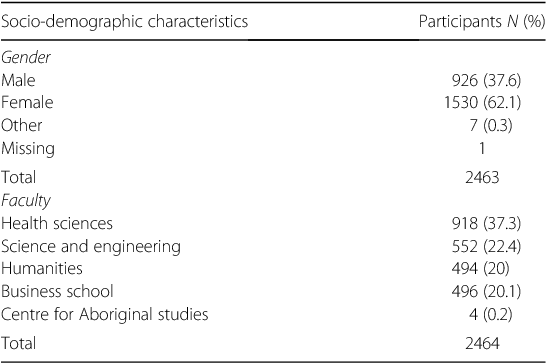
|
PCA was conducted on 16 of the 17 APS items. The item ‘you drove a car after you had perhaps had too much to drink’ (drink-driving) was removed as it did not correlate highly enough with any of the other items. As the harm factors were likely to be related, oblique rotation was selected because this allows for correlations among factors.29,30
The sampling adequacy for the analysis (KMO = 0.87) is considered ‘great’ by Field.28 Inclusion of items was determined and supported using KMO values for individual items and Bartlett’s test of sphericity. Three components had eigenvalues over Kaiser’s criterion of 1 and cumulatively explained 48.67% of the variance. Based on the item loadings, three components are suggested:
1. Component 1: Criminal and Aggressive Behaviour (7 items)
2. Component 2: Health and Emotional Harms (5 items)
3. Component 3: Sexual Harm (3 items).
After the initial PCA the item: ‘you were a passenger in a car with someone who had perhaps had too much to drink’ (drink-riding) was removed as it did not load highly on any particular factor. Field28 suggests correlation of items above 0.4 to be included in exploratory factor analysis. The two items relating to drink-driving and drink-riding were analysed individually and as part of the full APS. The final three components and their item loadings are shown in Table 2.
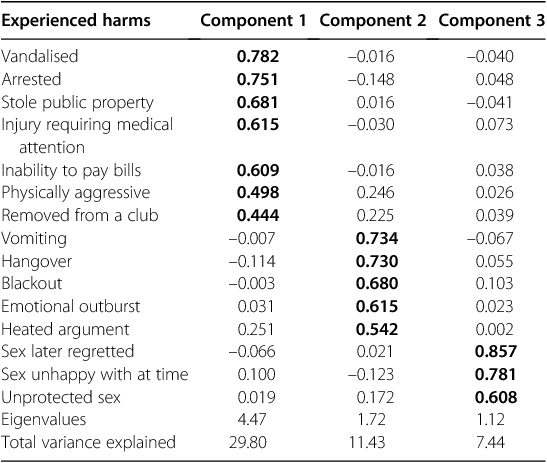
|
Valid scores on the three factors were provided by 1995 students. Students who reported high-risk consumption were significantly more likely to score highly on all three factors than those who reported low-risk consumption (Table 3). Males were significantly more likely than females to score highly on Criminal and Aggressive Behaviour and Sexual Harm (Table 4).
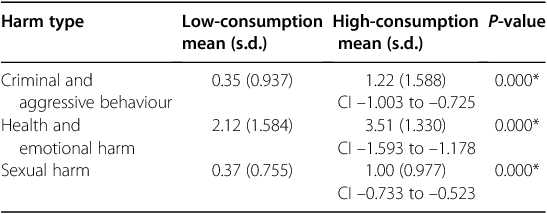
|
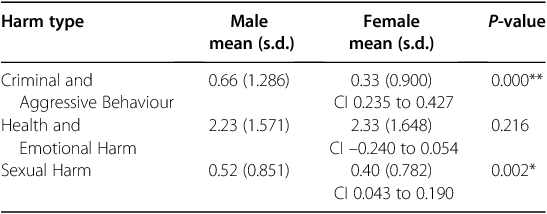
|
Students who reported consuming alcohol during the last 12 months (n = 2061; 89.1%) completed the AUDIT score questions. Of the 2054 students that returned a valid AUDIT-C score the majority reported low-risk consumption (n = 1798; 87.5%). Females were significantly less likely than males to report high-risk consumption (OR = 0.293; CI = 0.222-.386; P <0.001). Students from the Faculty of Science and Engineering, followed by students from the Faculty of Humanities were significantly more likely to report high-risk consumption as opposed to low-risk consumption, compared with other Faculties. The Faculty of Science and Engineering had significantly more male respondents (P <0.001), however there were significantly more female respondents from the Faculty of Humanities (P <0.001).
Over 80% of students reported having experienced harm as a result of their own alcohol consumption (n = 1647; 82.6%). Just over 70% of students reported having experienced at least two of the 17 harms at least once (n = 1406; 70.5%), with more than 30% reporting experiencing more than five harms at least once (n = 620; 31%). More students experienced harm as a result of their own alcohol consumption (n = 1647; 82.6%) than experienced or witnessed harm due to other students’ alcohol consumption (n = 1063; 52.8% and n = 1019; 50.6%, respectively; Table 5). Students who reported high-risk consumption were significantly more likely to experience and witness all of the alcohol-related harms (P <0.001).
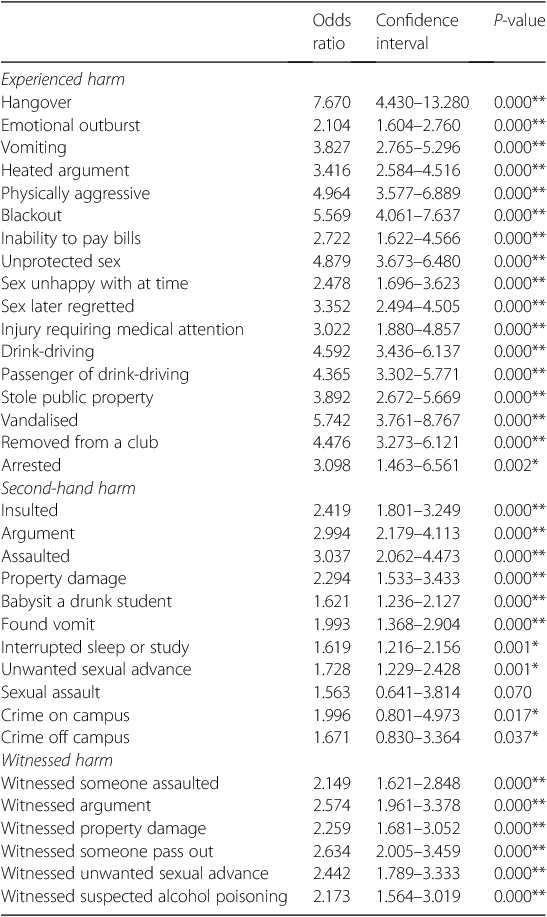
|
Regression analysis revealed that, when all factors were considered, total experienced harms, Criminal and Aggressive Behaviour and gender were significant predictors of high-risk consumption (P <0.001). Total witnessed harms and sexual harm were also significant predictors of high-risk consumption (P <0.05). Females were significantly less likely than males to consume alcohol at high-risk levels (OR 0.315; CI 0.233-.426; P <0.001). Students who reported high- isk consumption were 1.6 times more likely than those who reported low-risk consumption to experience harm, and were significantly more likely to report Criminal and Aggressive Behaviour (OR 0.624; CI 0.522-.745; P <0.001). Students who reported high-risk consumption were also significantly more likely to experience sexual harms than students who reported low-risk consumption (OR 0.796; CI 0.642-.986; P <0.05; see Table 6).
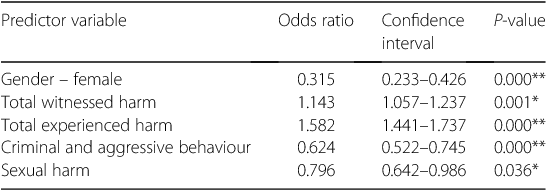
|
Discussion
The experienced and witnessed harms reported in this study are comparable to those of other studies of young Australian university students.5,7,10,17,31 Almost one-quarter of students reported high-risk consumption. Consistent with past research, males were more likely than females to report high-risk consumption.2,3,7,8,17
Similar to other studies,15,16,31,32 harm experienced as a result of students’ own alcohol consumption was assessed by a 17-item experienced-harm question. This study further analysed this question to identify associations between harm items. Three components were revealed: Criminal and Aggressive Behaviour, Health and Emotional Harm and Sexual Harm. Students reporting high-risk consumption were significantly more likely to experience Criminal and Aggressive Behaviour, Health and Emotional Harm and Sexual Harm compared with those reporting low-risk consumption.
Males were more likely than females to score highly on the Criminal and Aggressive Behaviour factor and the Sexual Harm factor. Other studies have also found that males are more likely than females to display aggressive and criminal behaviours when consuming alcohol.7,15 Males have also been found to experience more sexual harm associated with consuming alcohol than females; however, this difference is not always significant.7,15 Another Australian study found females were more likely to have been taken advantage of sexually as a result of their own drinking compared with males,7 while in this study there was little gender difference in regretted sexual encounters or a sexual situation they were unhappy about. Including more items around sexual harm due to one’s own drinking could provide greater depth to the Sexual Harm factor. There were no gender differences found for Health and Emotional Harm; past research has found little significant difference for most individual health and emotional harms between genders.7,15
Students who reported high-risk consumption were significantly more likely to encounter each of the harms listed across the three components compared with those reporting low-risk consumption. The harm most experienced was a hangover, followed by vomiting, blackouts and emotional outbursts; consistent with other research.7,15
Of the sexual harms, almost half of students reporting high-risk consumption had experienced unprotected sex, almost 20% experienced a sexual situation they were unhappy with at the time and over a third experienced a sexual situation they later regretted; consistent with past research.7,15,18 Unprotected sex increases the vulnerability of students to long-term consequences, such as pregnancy and sexually transmitted diseases.18
Over 50% of students reported experiencing second-hand harm or witnessing harm. The increased experience of second-hand and witnessed harms among students reporting high- compared with low-risk alcohol consumption supports previous findings that people who consume high levels of alcohol, not only experience more harm due to their own drinking but also experience more second-hand harms and witness more alcohol-related harm as a result of other people’s drinking.7,19
There has been little research into differences in alcohol consumption and harm among university faculties; however, preliminary research and anecdotal evidence suggests that differences do exist.33 Differences between levels of drinking and faculty warrant further investigation. Others have suggested links between certain personality characteristics and drinking in university students,34 and that personality characteristics inform a person’s alcohol-consumption patterns and also their chosen career path, and therefore chosen university faculty.33
When all variables were considered, being a male, experienced harm and Criminal and Aggressive Behaviours were significant predictors of high-risk consumption; witnessed harm and sexual harm were also associated with high-risk consumption.
When gender was included in this regression model it was found to be a significant predictor of high-risk consumption. When the same baseline data was entered into the regression model to predict hazardous drinking (total AUDIT ≥ 8), gender was not found to be a significant predictor.35 Witnessed harm was found to be a moderate predictor of high-risk consumption but was not found to be a significant predictor of hazardous consumption.35 These differences provide further support for the different use of AUDIT-C compared with overall AUDIT score when assessing harm in university students.
The Health and Emotional Harms factor was included in the initial regression analysis but was not found to be significant; possibly indicating that consuming alcohol at any level increases the likelihood of experiencing Health and Emotional Harm. Sexual Harm was not found to be significant in the first model but was found to be a moderate predictor of high-risk consumption once Health and Emotional Harm was removed. As it is only a moderate predictor, it may be similar to Health and Emotional Harm in that it has the potential to be experienced by students who report consumption at any level. Future research may explore whether university students are at higher risk of experiencing Health and Emotional Harm and Sexual Harm due to their alcohol consumption behaviours or if this population is at a higher risk of experiencing these harms in general. A study of sexual behaviours in university students in New Zealand revealed that unprotected sex among this population is very common; about half of their sample reported not having used a condom at their last sexual encounter.36
Conclusion
The findings of this study support the body of literature that describes the relationship between alcohol consumption and harm among Australian university students. High-risk alcohol consumption is common among university students aged 18–24 as is the prevalence of experienced and witnessed alcohol-related harms.
Being aware of the risk factors of particular groups of people allows health promotion practitioners to better design interventions that can specifically target these risk factors in particular groups.37 For example, knowing that males are more likely than females to exhibit Criminal and Aggressive Behaviour allows for the development of specific strategies targeting males. University-based interventions31,38 explored in this study targeted males and females and different student groups in the same manner. These study findings suggest some strategies should be tailored for specific groups.
The categorisation of harms into factors allows more specific definition and suggests distinct factors among alcohol-related experienced harms. Not only does this provide a different method of evaluating alcohol-related harm but it also allows for a more informed approach to the development of interventions that target alcohol-related harms. As these factors are able to categorise alcohol-related harm their use in future studies will give more insight into different groups’ experience of harm and therefore how these groups may be more effectively targeted.
Acknowledgements
The authors would like to acknowledge Healthway. The authors would also like to acknowledge all Contributing Investigators: Gemma Crawford, Dr Jonathan Hallett, Dr Jonine Jancey, Dr Linda Portsmouth and Janelle Longo.
References
[1] National Health and Medical Research Council. Australian guidelines to reduce health risks from drinking alcohol. Canberra: National Health and Medical Research Council; 2009.[2] Adhikari P, Batts D, Harrold T. Drinking patterns in Australia, 2001–2007. Canberra: Australian Institute of Health and Welfare; 2010.
[3] Tomlin S, Joyce S. Health and wellbeing of adults in Western Australia 2012, overview and trends. Western Australia: Department of Health; 2013.
[4] Borglagdan J, Freeman T, Duvnjak A, Lunnay B, Bywood P, Roche AM. From ideal to reality: Cultural contradictions and young people’s drinking. Flinders University, Adelaide: National Centre for Education and Training on Addiction; 2010.
[5] Davey J, Davey T, Obst P (2002) Alcohol consumption and drug use in a sample of Australian university students. Youth Stud Aust 21, 25–32.
[6] Johnston KL, White KM (2004) Binge-drinking in female university students. Youth Stud Aust 23, 22–30.
[7] Rickwood D, George A, Parker R, Mikhailovich K (2011) Harmful alcohol use on campus: impact on young people at university. Youth Studies Australia 30, 34–40.
[8] Mathers C, Stevens G, Mascarenhas M. Global health risks: mortality and burden of disease attributable to selected major risks. Paris: World Health Organization; 2009.
[9] Australian Institute of Health and Welfare National Drug Strategy Household Survey detailed report 2013. Drug statistics series no. 28. Cat. no. PHE 183. Canberra: AIHW; 2014.
[10] Kypri K, Cronin M, Wright CS (2005) Do university students drink more hazardously than their non-student peers? Addiction 100, 713–4.
| Do university students drink more hazardously than their non-student peers?Crossref | GoogleScholarGoogle Scholar | 15847629PubMed |
[11] Ståhlbrandt H, Andersson C, Johnsson KO, Tollison SJ, Berglund M, Larimer ME (2008) Cross-cultural patterns in college student drinking and its consequences – a comparison between the USA and Sweden. Alcohol Alcoholism 43, 698–705.
| Cross-cultural patterns in college student drinking and its consequences – a comparison between the USA and Sweden.Crossref | GoogleScholarGoogle Scholar | 18593864PubMed |
[12] Ham LS, Hope DA (2003) College students and problematic drinking: a review of the literature. Clin Psychol Rev 23, 719–59.
| College students and problematic drinking: a review of the literature.Crossref | GoogleScholarGoogle Scholar | 12971907PubMed |
[13] Gill JS (2002) Reported levels of alcohol consumption and binge drinking within the UK undergraduate student population over the last 25 years. Alcohol Alcoholism 37, 109–20.
| Reported levels of alcohol consumption and binge drinking within the UK undergraduate student population over the last 25 years.Crossref | GoogleScholarGoogle Scholar | 11912065PubMed |
[14] Griffin C, Bengry-Howell A, Hackley C, Mistral W, Szmigin I (2009) ‘Every time I do it I absolutely annihilate myself’: loss of (self-)consciousness and loss of memory in young people’s drinking narratives. Sociology 43, 457–76.
| ‘Every time I do it I absolutely annihilate myself’: loss of (self-)consciousness and loss of memory in young people’s drinking narratives.Crossref | GoogleScholarGoogle Scholar |
[15] Kypri K, Paschall MJ, Langley J, Baxter J, Cashell-Smith M, Bourdeau B (2009) Drinking and alcohol-related harm among New Zealand university students: findings from a national web-based survey. Alcohol ClinExp Res 33, 307–14.
| Drinking and alcohol-related harm among New Zealand university students: findings from a national web-based survey.Crossref | GoogleScholarGoogle Scholar |
[16] McGee R, Kypri K (2004) Alcohol-related problems experienced by university students in New Zealand. Aust NZ J Publ Health 28, 321–3.
| Alcohol-related problems experienced by university students in New Zealand.Crossref | GoogleScholarGoogle Scholar |
[17] Hallett J, Howat P, Maycock B, McManus A, Kypri K, Dhaliwal S (2012) Undergraduate student drinking and related harms at an Australian university: web-based survey of a large random sample. BMC Public Health 12, 37
| Undergraduate student drinking and related harms at an Australian university: web-based survey of a large random sample.Crossref | GoogleScholarGoogle Scholar | 22248011PubMed |
[18] Connor J, Psutka R, Cousins K, Gray A, Kypri K (2013) Risky drinking, risky sex: a national study of New Zealand university students. Alcoholism 37, 1971–8.
| Risky drinking, risky sex: a national study of New Zealand university students.Crossref | GoogleScholarGoogle Scholar | 23895314PubMed |
[19] Langley JD, Kypri K, Stephenson SCR (2003) Secondhand effects of alcohol use among university students: computerised survey. BMJ 327, 1023–4.
| Secondhand effects of alcohol use among university students: computerised survey.Crossref | GoogleScholarGoogle Scholar | 14593036PubMed |
[20] Hernandez L, Leontini R, Harley K (2013) Alcohol, university students, and harm-minimization campaigns: ‘a fine line between a good night out and a nightmare’. Contemp Drug Probl 40, 157–89.
| Alcohol, university students, and harm-minimization campaigns: ‘a fine line between a good night out and a nightmare’.Crossref | GoogleScholarGoogle Scholar |
[21] Miller P, Palmer D, McFarlane E, Curtis A (2014) Key stakeholder views of venue lockouts in Newcastle and Geelong. Crime PrevComm Safe 16, 38–53.
| Key stakeholder views of venue lockouts in Newcastle and Geelong.Crossref | GoogleScholarGoogle Scholar |
[22] Hallett J, Maycock B, Kypri K, Howat P, McManus A (2009) Development of a web-based alcohol intervention for university students: processes and challanges. Drug Alcohol Rev 28, 31–9.
| Development of a web-based alcohol intervention for university students: processes and challanges.Crossref | GoogleScholarGoogle Scholar | 19320673PubMed |
[23] Burns S, Jancey J, Bowser N, Comfort J, Crawford G, Hallett J, et al (2013) Moving forward: a cross sectional baseline study of staff and student attitudes towards a totally smoke free university campus. BMC Public Health 13, 738
| Moving forward: a cross sectional baseline study of staff and student attitudes towards a totally smoke free university campus.Crossref | GoogleScholarGoogle Scholar | 23924040PubMed |
[24] Saunders JB, Aasland OG, Babor TF, de la Fuente JR, Grant M (1993) Development of the Alcohol Use Disorders Identification Test (AUDIT): WHO Collaborative project on early detection of persons with harmful alcohol consumption – II. Addiction 88, 791–804.
| Development of the Alcohol Use Disorders Identification Test (AUDIT): WHO Collaborative project on early detection of persons with harmful alcohol consumption – II.Crossref | GoogleScholarGoogle Scholar | 1:STN:280:DyaK3szitVOltw%3D%3D&md5=20a650032f201be5baed0e71f9248090CAS | 8329970PubMed |
[25] Bradley KA, De Benedetti AF, Volk RJ, Williams EC, Frank D, Kivlahan DR (2007) AUDIT-C as a brief screen for alcohol misuse in primary care. Alcohol ClinExp Res 31, 1208–17.
| AUDIT-C as a brief screen for alcohol misuse in primary care.Crossref | GoogleScholarGoogle Scholar |
[26] Australian Government. Alcohol Screen (AUDIT). In Affairs DoVs, editor.
[27] Wechsler H, Lee JE, Kuo M, Seibring M, Nelson TF, Lee H (2002) Trends in college binge drinking during a period of increased prevention efforts: findings from 4 Harvard School of Public Health College Alcohol Study surveys: 1993–2001. J Am Coll Health 50, 203–17.
| Trends in college binge drinking during a period of increased prevention efforts: findings from 4 Harvard School of Public Health College Alcohol Study surveys: 1993–2001.Crossref | GoogleScholarGoogle Scholar | 11990979PubMed |
[28] Field A. Discovering statistics using SPSS, 3rd edn. London: SAGE Publications; 2009.
[29] Tabachnick BG, Fidell LS. Using multivariate statistics, 5th edn. Boston, Mass: Allyn and Bacon; 2001.
[30] Fabrigar LR, Wegener DT, MacCallum RC, Strahan EJ (1999) Evaluating the use of exploratory factor analysis in psychological research. Psychol Methods 4, 272–99.
| Evaluating the use of exploratory factor analysis in psychological research.Crossref | GoogleScholarGoogle Scholar |
[31] Kypri K, Hallett J, Howat P, McManus A, Maycock B, Bowe S, et al (2009) Randomized controlled trial of proactive web-based alcohol screening and brief intervention for university students. Arch Intern Med 169, 1508–14.
| Randomized controlled trial of proactive web-based alcohol screening and brief intervention for university students.Crossref | GoogleScholarGoogle Scholar | 19752409PubMed |
[32] Hallett J, Howat P, McManus A, Meng R, Maycock B, Kypri K (2013) Academic and personal problems among Australian university students who drink at hazardous levels: web-based survey. Health Promot J Austr 24, 170–7.
| Academic and personal problems among Australian university students who drink at hazardous levels: web-based survey.Crossref | GoogleScholarGoogle Scholar | 1:STN:280:DC%2BC2c3ovV2isw%3D%3D&md5=959a2428a9e6b33ed041f2e53cea4af1CAS | 24355337PubMed |
[33] Webb E, Ashton H, Kelly P, Kamali F (1997) Patterns of alcohol consumption, smoking and illicit drug use in British university students: interfaculty comparisons. Drug Alcohol Depend 47, 145–53.
| Patterns of alcohol consumption, smoking and illicit drug use in British university students: interfaculty comparisons.Crossref | GoogleScholarGoogle Scholar | 1:STN:280:DyaK2svktlGjsg%3D%3D&md5=2a8cf845b6f83f70763463e88a6d0cfdCAS | 9298336PubMed |
[34] Hosier SG, Cox WM (2011) Personality and motivational correlates of alcohol consumption and alcohol-related problems among excessive drinking university students. Addict Behav 36, 87–94.
| Personality and motivational correlates of alcohol consumption and alcohol-related problems among excessive drinking university students.Crossref | GoogleScholarGoogle Scholar | 20875705PubMed |
[35] Burns S, Crawford G, Hallett J, Jancey J, Portsmouth L, Hunt K, et al (2015) Consequences of low risk and hazardous alcohol consumption among university students and implications for health promotion interventions. Open J Prev Med 5, 1–13.
| Consequences of low risk and hazardous alcohol consumption among university students and implications for health promotion interventions.Crossref | GoogleScholarGoogle Scholar |
[36] Psutka R, Connor J, Cousins K, Kypri K (2012) Sexual health, risks, and experiences of New Zealand university students: findings from a national cross-sectional study. New Zeal Med J 125, 62–73.
[37] Burns S, Portsmouth L. Health promotion. In Allen F, editor. Health psychology and behaviour in Australia; 2010.
[38] Stritzke W, Wylde T, Dove E, Erceg-Hurn D. Brief Alcohol Intervention Training (BAIT). Perth: University of Western Australia; 2012.

